Kraljic Matrix for Supplier Segmentation Explained


Key Takeaways:
Today, numerous supplier segmentation tools and strategies are available for modern procurement teams.
However, there’s one method that has stood the test of time and continues to prove its usefulness: the Kraljic Matrix.
This established supplier classification tool remains a fundamental concept in strategic procurement and supply chain management.
In this article, we’ll explore the history of the Kraljic Matrix, how it works, its advantages and disadvantages, and how it’s used today.
So, if you want to deepen your understanding of the Kraljic Matrix and its role in effective supplier segmentation, read on.
While we’ll go into the details of how the Kraljic Matrix is used in the next section, for now, let’s give you a short definition.
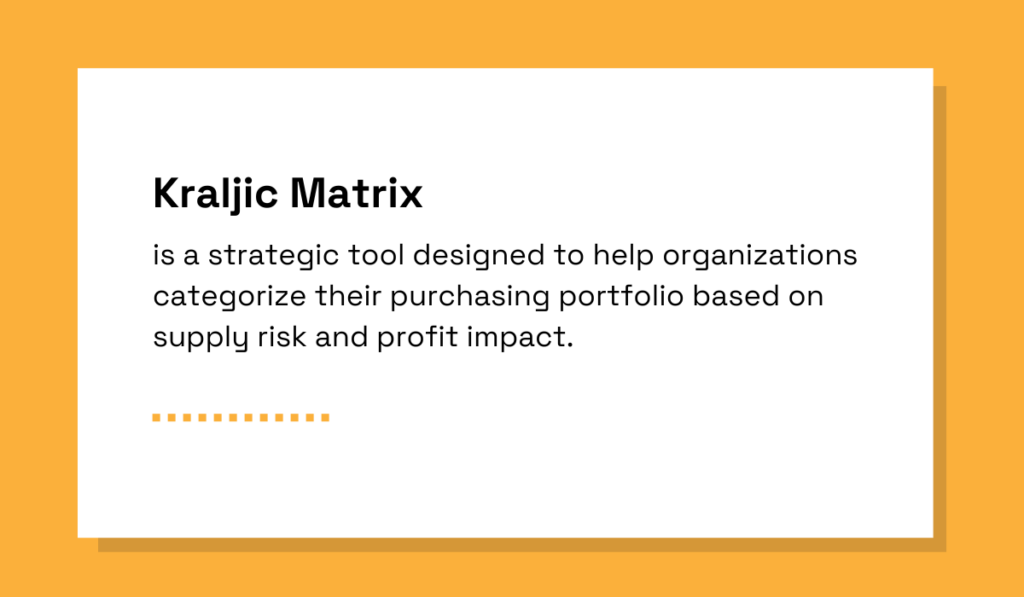
Source: Veridion
The Kraljic Matrix is a tool that helps with supplier segmentation through their categorization based on two criteria.
The matrix was developed by Peter Kraljic, a German procurement expert, in 1983.
Kraljic recognized that companies were not effectively managing their supplier relationships.
So, he created a framework that would allow businesses to strategically assess their suppliers and develop appropriate strategies for each.
And that’s the essence of it.
A more detailed explanation of the matrix and Kraljic’s rationale for its creation can be found in his 1983 Harvard Business Review article, “Purchasing Must Become Supply Management.”

Source: HBR
In it, Kraljic outlines his method for strategically managing suppliers amidst the volatile market conditions of his time.
Make sure to take a look at the article and his arguments for a more strategic approach to purchasing, moving beyond simply securing the lowest price.
After its creation, this method became a key supplier segmentation tool and greatly revolutionized the field of procurement.
In fact, Kraljic himself aimed to elevate the procurement function from a purely transactional role to a strategic one, emphasizing the importance of supplier relationships in achieving overall business objectives.
But with all this rich history, today, some argue that the Kraljic Matrix is outdated.
Nicolò Masserano, director at BearingPoint, an independent management and technology consultancy, explains.
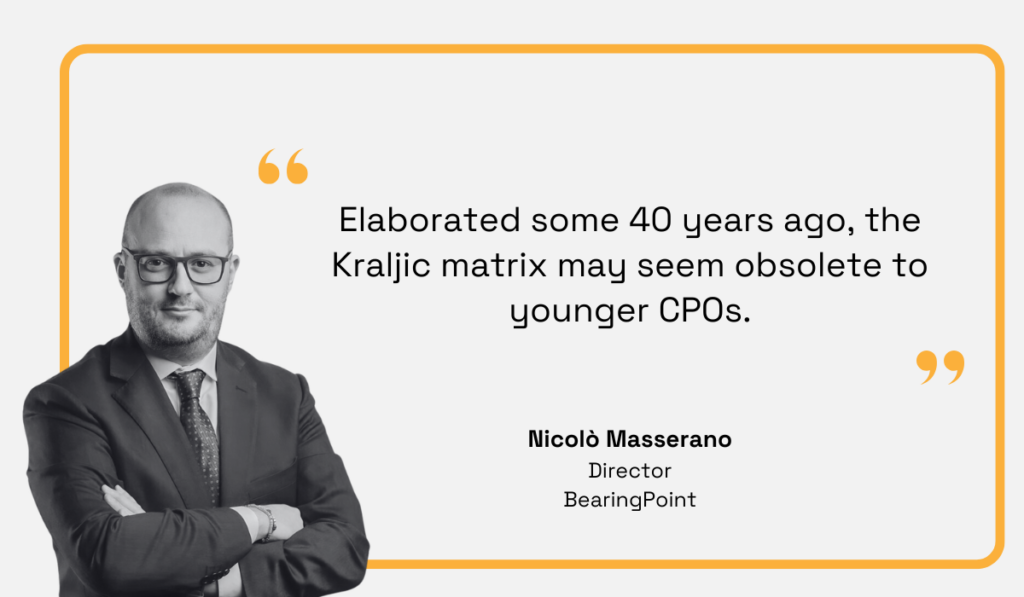
Illustration: Veridion / Quote: BearingPoint
However, Masserano urges us to acknowledge the significant historical impact of the Kraljic Matrix and how it was the basis for modern methods.
Plus, he emphasizes that it remains a relevant framework for analyzing procurement activities and developing effective sourcing strategies to this day.
That being said, we hope you got a basic understanding of the historical context and intent of the Kraljic Matrix.
Let’s now explore how the Kraljic Matrix functions.
The matrix uses two primary metrics for categorization, represented as the axes: profit impact and supply risk.
Profit impact refers to the influence a supplier has on an organization’s overall profitability.
Supply risk, on the other hand, represents the potential for disruptions or difficulties in obtaining goods or services from a particular supplier.
The matrix uses two levels for each metric: low and high, as illustrated below.
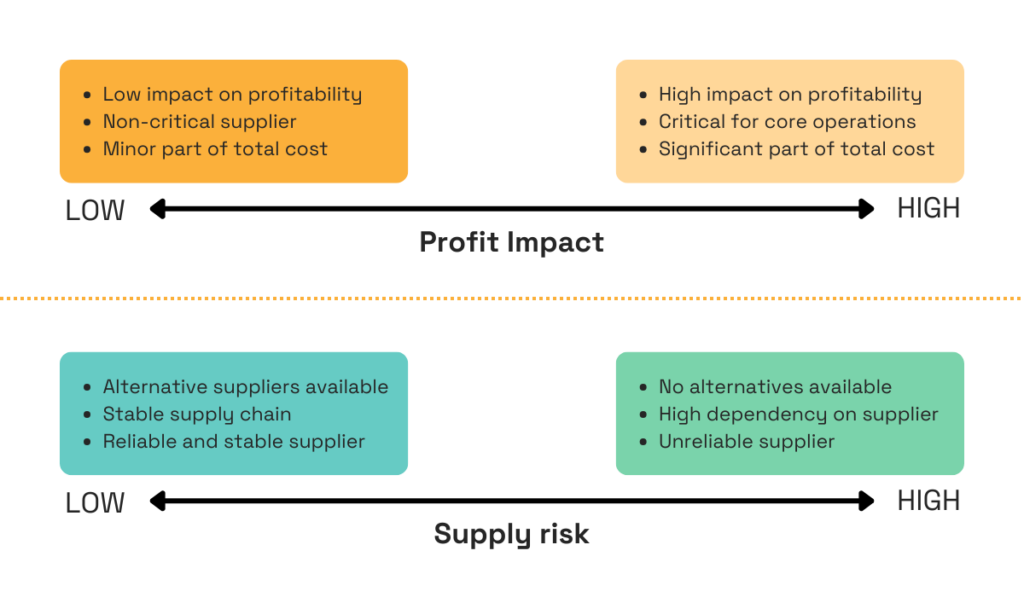
Source: Veridion
While our illustration shows some common characteristics of suppliers falling into low and high levels for each category, organizations should assess risk and profit impact levels based on their specific circumstances.
For example, a company operating in a highly regulated industry should consider regulatory compliance a key factor in assessing supply risk.
Moreover, a company with a strong focus on innovation should place a higher emphasis on a supplier’s ability to contribute to new product development when evaluating profit impact.
Now, let’s look at how these two axes create the four quadrants of the Kraljic Matrix, shown below.
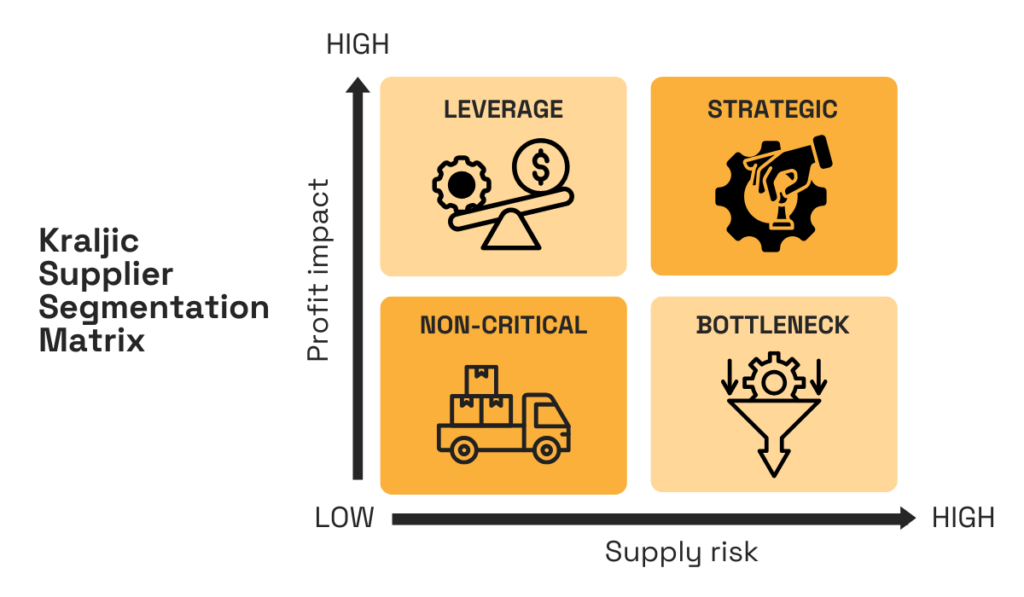
Source: Veridion
Let’s break down each of these quadrants in the following table.
| Quadrant | Risk and profit impact | Key Features | Strategy |
|---|---|---|---|
| Strategic Items | High supply risk, high profit impact | Few suppliers, critical to operations | Long-term partnerships, supplier development |
| Leverage Items | Low supply risk, high profit impact | Many suppliers, competitive prices | Exploit purchasing power, negotiate aggressively |
| Bottleneck Items | High supply risk, low profit impact | Few alternatives, unpredictable availability | Secure supply, develop contingency plans |
| Non-Critical Items | Low supply risk, low profit impact | Routine purchases, easy substitutes | Simplify processes, automate procurement |
As we can’t go into too much detail here, for a more thorough explanation of each quadrant, we invite you to read our other article on the topic.
In any case, to use the matrix, you would evaluate suppliers based on the potential supply risk and their impact on your profits.
This assessment should involve gathering data from various sources, including internal stakeholders, market research, and supplier performance data.
Once you have assessed each supplier, you would place them in the appropriate quadrant, allowing you to visualize your entire supply base and identify potential vulnerabilities or opportunities.
For a more practical example, take a look at the next image.
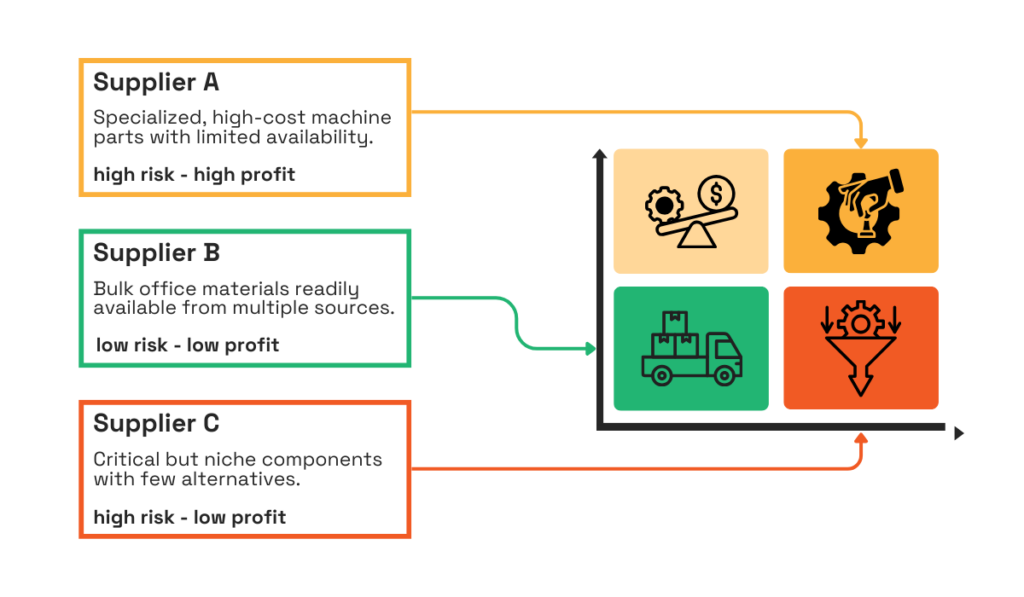
Source: Veridion
Although simplified, this example demonstrates how different suppliers providing various products can be categorized within the four quadrants.
To round off this section, we encourage you to analyze your own supply base.
Try to assess the risk and profit impact of some of your key suppliers and perform a preliminary categorization using the Kraljic Matrix.
This exercise will provide valuable insights into your current supplier relationships and help you identify potential areas for improvement in your procurement strategy.
You might be hesitant to start using the Kraljic Matrix, so in this section, we’ll explore the numerous benefits of using it.
Below is an overview of the main benefits.
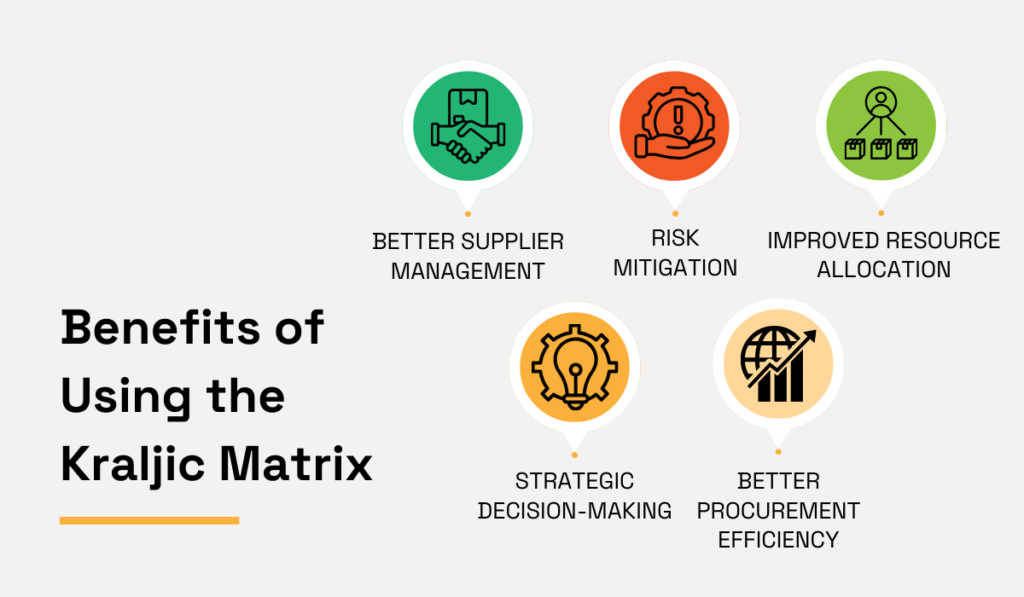
Source: Veridion
For starters, the Kraljic Matrix facilitates better supplier management by providing a clear framework for segmenting suppliers and allowing you to develop tailored strategies for each one.
The matrix also directly improves risk mitigation by highlighting potential supply chain vulnerabilities, represented as the X-axis on the matrix, and helping pinpoint whether some key suppliers open you up to risk.
Next, we have improved resource allocation, and a study from 2022 provides a great example of this benefit.
In short, researchers used the Kraljic Matrix, among other methods, to categorize medicine purchasing at a hospital center.

Illustration: Veridion / Source: Science Direct
The researchers found that the hospital misallocated many of their resources by employing overly complex purchasing processes for non-critical medicines.
After employing the Matrix, the study experts proposed distinct strategies based on the different quadrants, ranging from competitive bidding for leverage items to a greater focus on building relationships with strategic suppliers.
This study highlighted two additional benefits: strategic decision-making, and increased efficiency in procurement operations.
In fact, Sjoerd Goedhart, owner of a management and consultancy firm, recounts how he used the matrix in strategic planning during his time as a procurement expert for a retail company.
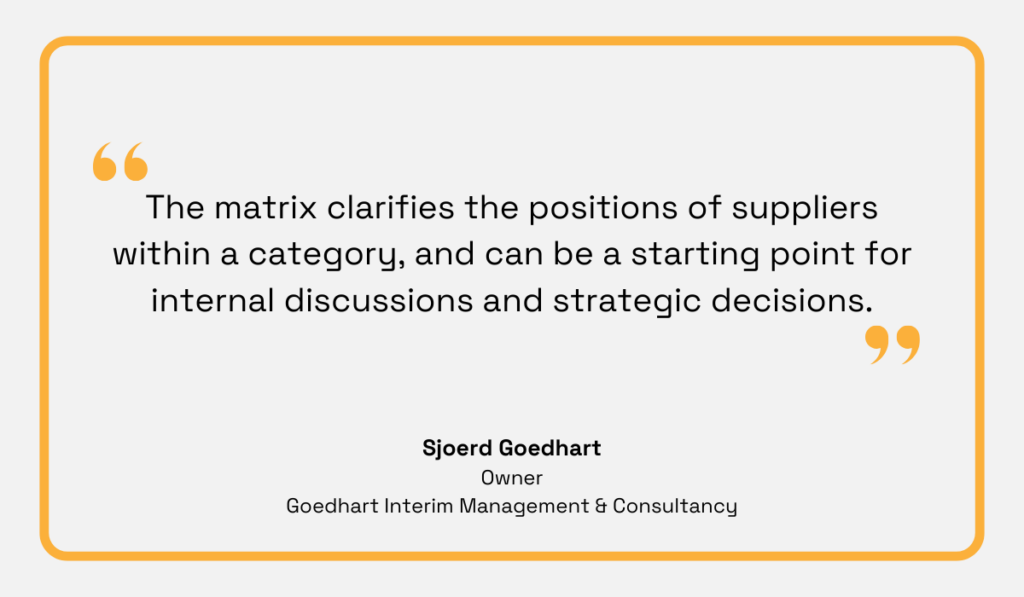
Illustration: Veridion / Quote: Procurement Tactics
He explains that he used the matrix as a foundation for making strategic choices in annual plans.
It also guided his discussions with category managers.
Together, they evaluated which supplier relationships to invest in and which ones to step back from.
Overall, the Kraljic Matrix empowers organizations to optimize their entire procurement strategies with these meaningful benefits.
But, we’d be lying if we said this method is without its faults.
For starters, while the matrix’s focus on risk and profit impact effectively streamlines supplier segmentation, it also risks oversimplification.
In fact, this matrix does not account for many key aspects of modern procurement, some of which are illustrated below.
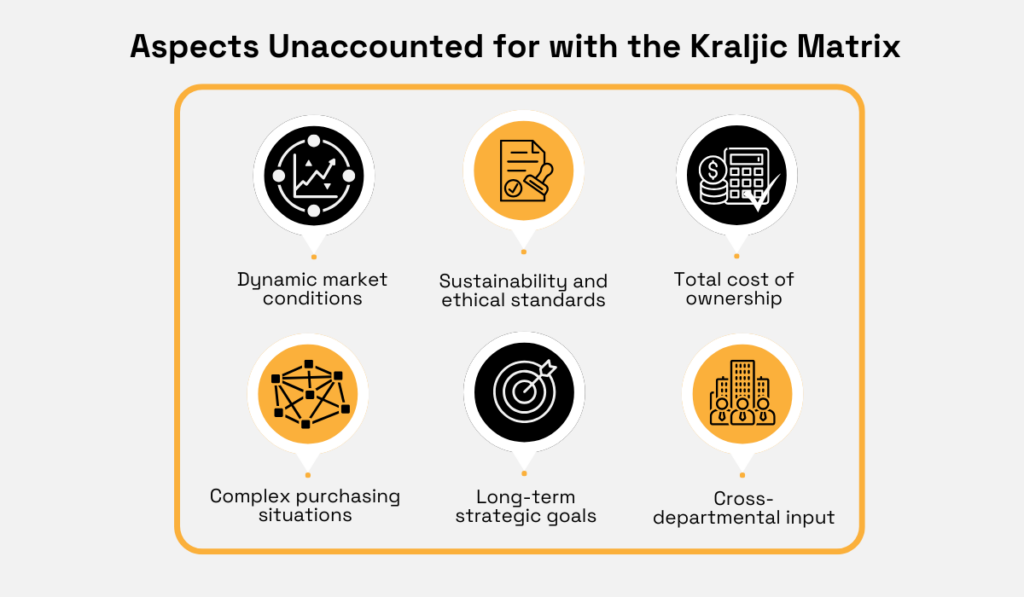
Source: Veridion
The Kraljic Matrix doesn’t fully account for dynamic market conditions and complex purchasing situations, and its static nature can make it challenging to adapt to rapidly changing markets or complex supply chains.
For instance, a sudden surge in demand for a particular raw material could significantly increase its supply risk, potentially shifting a supplier from one quadrant to another.
However, the matrix itself doesn’t inherently account for such fluctuations, requiring manual reassessment and recategorization.
Plus, as Philip Ideson, founder and director of the Art of Procurement, explains, the matrix focuses too heavily on present circumstances.
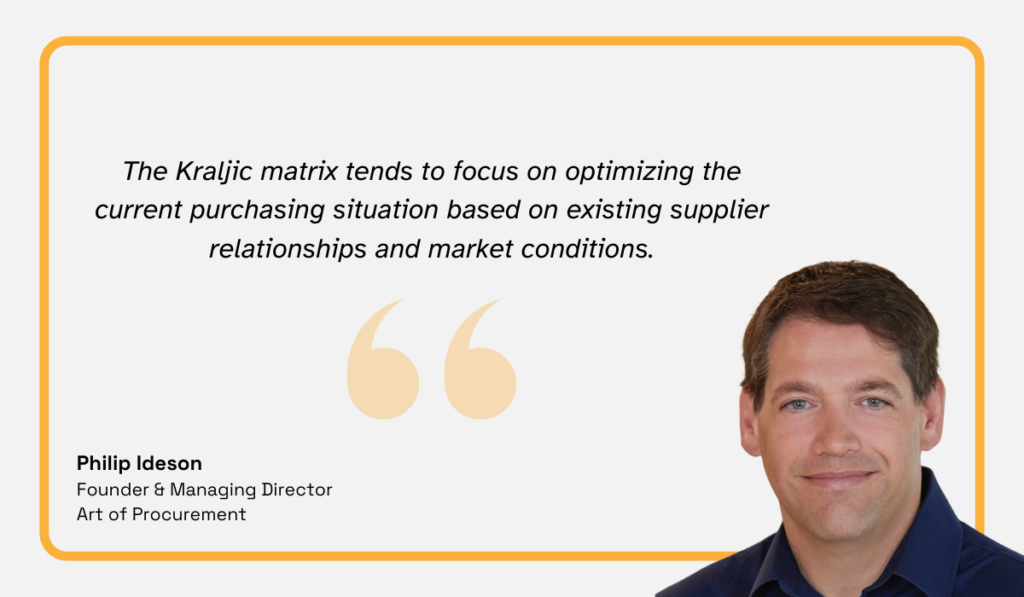
Illustration: Veridion / Quote: Art of Procurement
Contemporary procurement often emphasizes long-term goals, which can clash with the matrix’s present-focused approach.
Ideson elaborates that a product might fall into one quadrant in the present but, based on an organization’s future objectives, should be treated as belonging to a different quadrant to facilitate long-term planning.
Finally, it’s worth noting that the Kraljic Matrix doesn’t explicitly account for supply chain sustainability and ethical considerations.
These factors are increasingly important in modern procurement, but the matrix doesn’t provide a framework for incorporating them into supplier segmentation and strategy.
This point is echoed by Graham Copeland, senior director of business development at GEP Worldwide.
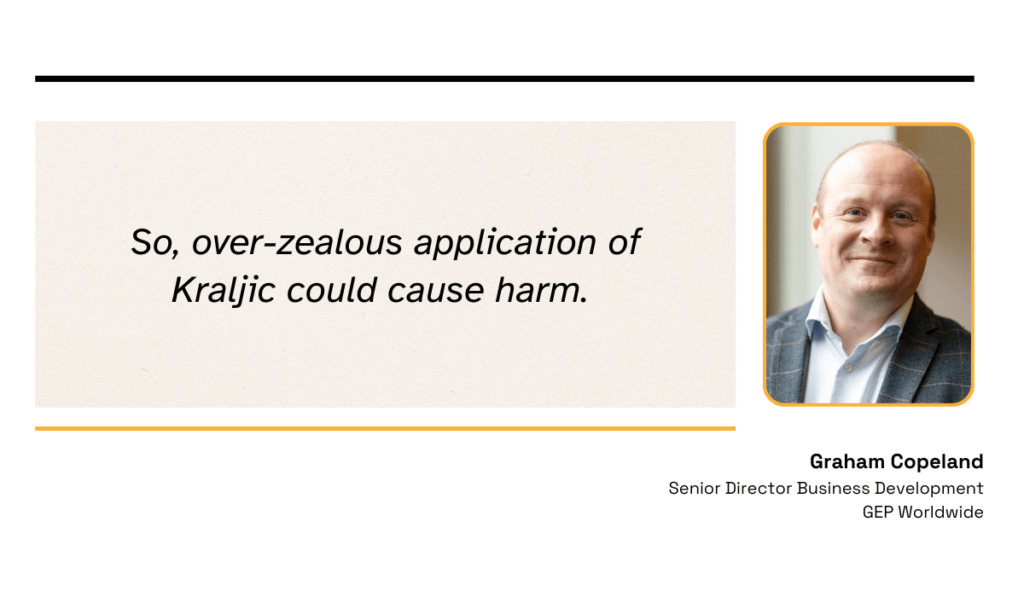
Illustration: Veridion / Quote: GEP
Copeland highlights potential ethical and sustainability issues across all quadrants.
For instance, aggressive pricing strategies for Leverage items can drive suppliers to negative margins.
And, in the Non-critical quadrant, last-minute purchasing changes by a procurement organization can create income uncertainty for suppliers.
All of this necessitates careful application of the Kraljic Matrix.
While undeniably a useful tool, you must account for its limitations for a comprehensive and responsible procurement strategy.
Despite its limitations, the Kraljic Matrix remains prevalent in modern procurement.
A prime example is SAP Ariba, a cloud-based procurement and supply chain management platform.
As shown below, SAP Ariba incorporates the Kraljic Matrix as a readily available feature.

Source: SAP
This integration allows for a seamless application of the matrix within the broader procurement workflow, facilitating data-driven decision-making and improved supplier relationship management.
And while other similar systems follow suit, it’s important to note that the matrix isn’t typically used as a standalone procurement tool.
Its effectiveness is amplified when combined or integrated with other digital systems for supplier relationship and risk management.
These complementary tools provide additional layers of insight and functionality, enabling a more holistic and nuanced approach to procurement.
For example, integrating the Kraljic Matrix with supplier relationship management (SRM) software can improve communication and collaboration with key suppliers.
On the other hand, integration with risk management tools can facilitate proactive mitigation of potential supply chain disruptions.
Furthermore, as the Matrix relies on high-quality supplier data, particularly risk data, this requires the use of external data sources and services like Veridion.
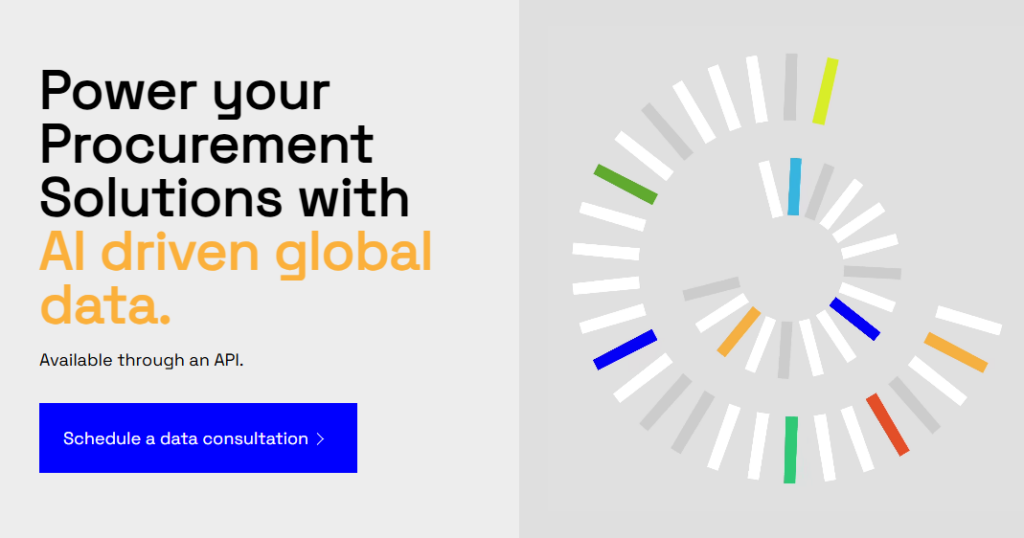
Source: Veridion
Veridion offers a global, AI-curated database of over 120 million companies worldwide, updated weekly.
It provides accurate insights into suppliers, their products, sustainability and ESG practices, regulatory compliance, and other vital information.
Plus, Veridion’s real-time notifications can alert users to any supplier risk, enabling procurement teams to make immediate updates to the Kraljic Matrix and adjust their strategies accordingly.
This real-time responsiveness is crucial as organizations increasingly move away from pure profits and prioritize the “triple bottom line” that includes profit, people, and planet.
This shift has even led to a proposed update of the Kraljic Matrix, replacing the Y-axis with “triple bottom line impact,” along with some quadrant adjustments.
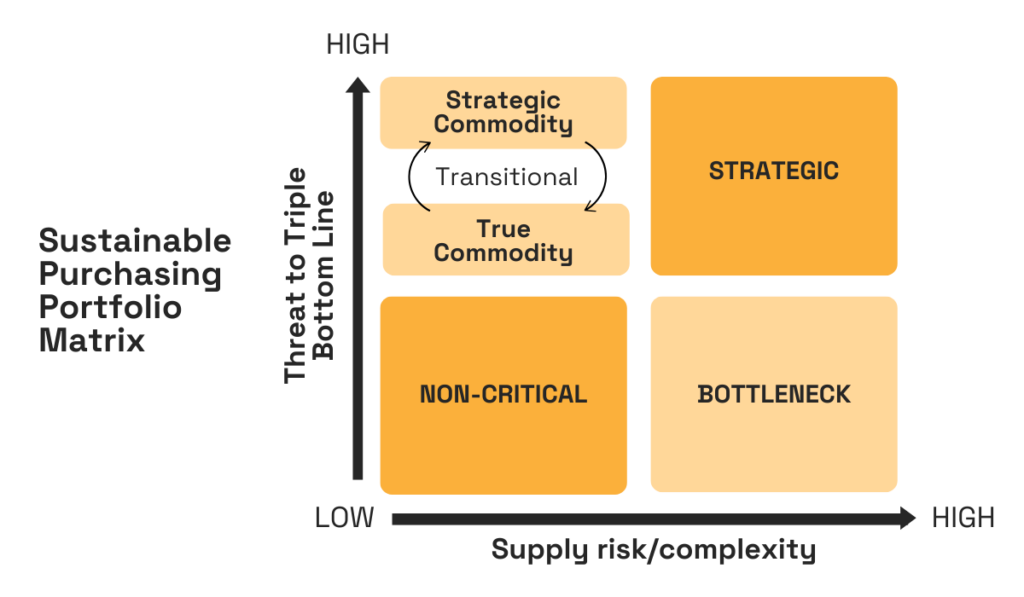
Illustration: Veridion / Source: GEP
This updated matrix distinguishes between three types of leverage items:
This refined approach allows for a more granular assessment of supplier importance and facilitates the development of tailored strategies that align with the organization’s broader sustainability objectives.
Ultimately, it’s clear that the Kraljic Matrix continues to evolve and adapt to the complexities of modern procurement.
Even though it was developed over 40 years ago, the Kraljic Matrix is still a valuable tool for supplier segmentation.
Hopefully, you now have a clearer understanding of how it works and how it can help analyze your own supply base.
So, go ahead and apply the Kraljic Matrix and its modern variations to build stronger supplier relationships and optimize your procurement performance.